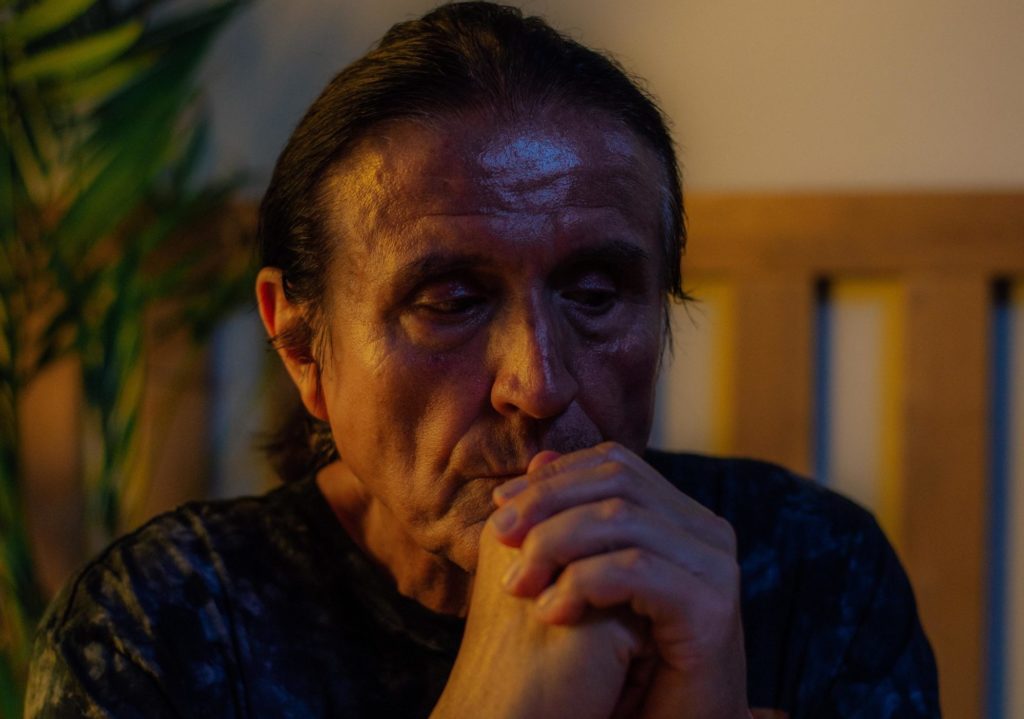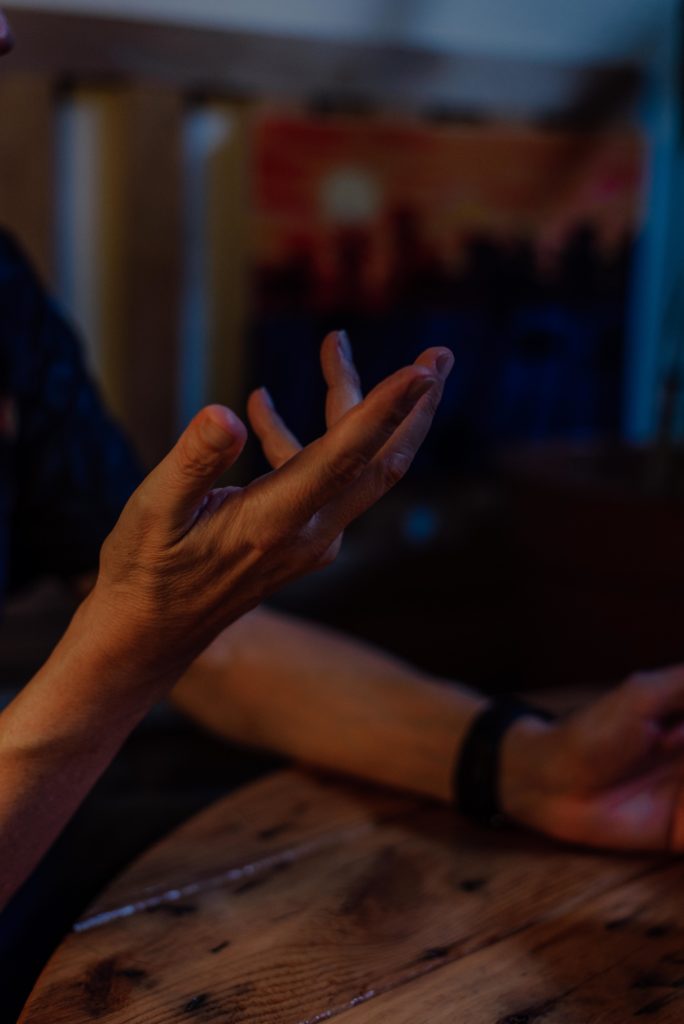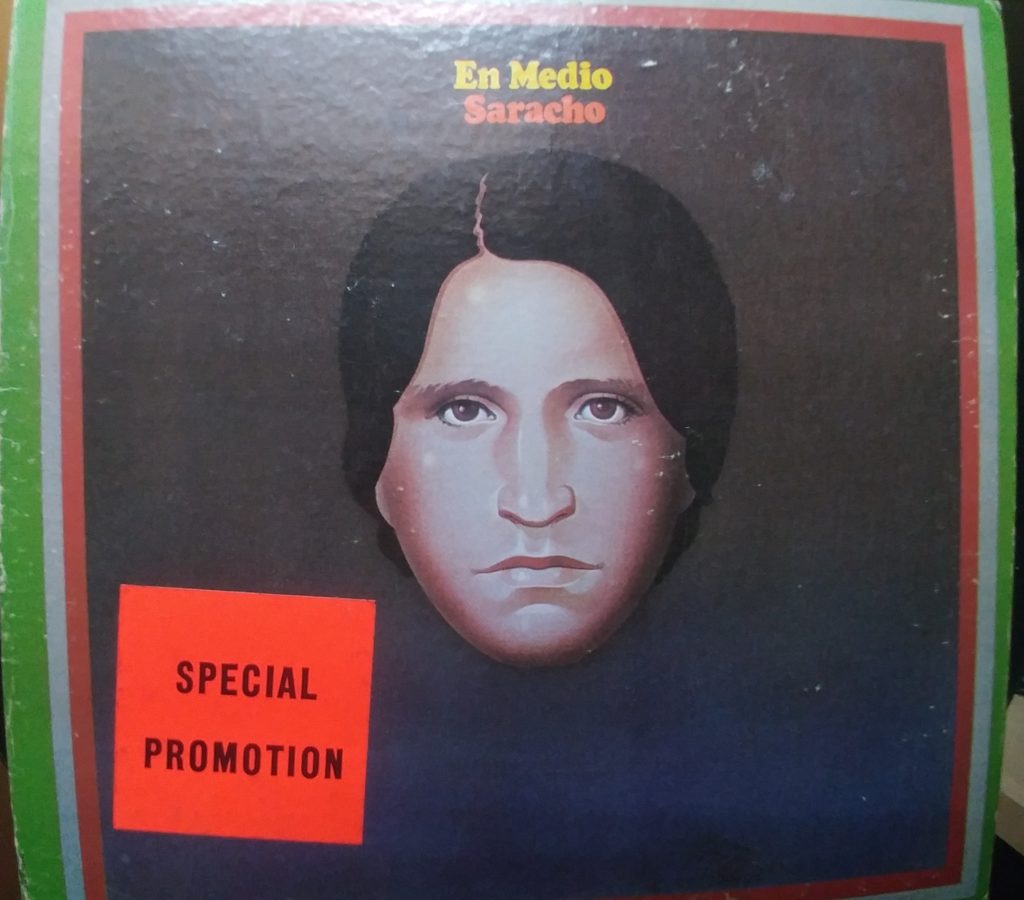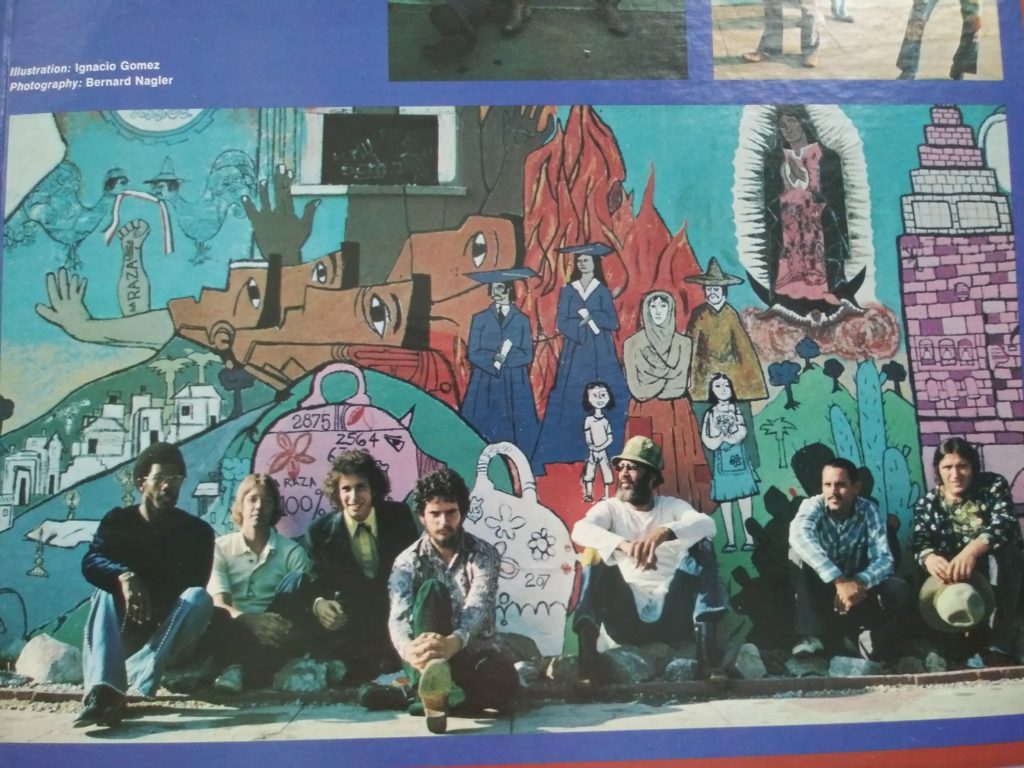Before working in obscurity on sound stages, Garrett Saracho was a rising star who performed on jazz stages all across Los Angeles. Having once been signed to Impulse!, the label behind jazz greats like John Coltrane, Saracho represented what the New York Times declared in a 1973 article as “the Impulse West-Coast contingent.”
As a teenager, Saracho had played the vibraphone alongside his friend Herbie Baker. Their quintet was affiliated with local jazz icon Horace Tapscott’s extended universe of musicians known as the Union of God’s Musicians and Artist Ascension, or UGMAA. Later, Saracho’s panoramic blend of Chicano rock & jazz-funk would earn him fans in high places, including Herbie Hancock, Wayne Shorter, and Jaco Pastorius. He won UCLA’s prestigious Frank Sinatra Music Award in 1970 and once played a set with Buddy Miles, John Paul Jones of Led Zeppelin, and Jimi Hendrix at the long-shuttered Thee Experience on Sunset Boulevard in Hollywood. By that point, Saracho was on the cusp of announcing himself as a major new voice in jazz.
That record is important because it’s part of a tradition of community-driven music in Los Angeles
Robert Miranda, a musician who recorded on En Medio
But no such announcement ever came. After the ill-timed release of his sole available recording, the 1973 LP En Medio, a disillusioned Saracho shelved his aspirations of celebrity. He returned to school, found work as a carpenter in the film industry and years later toured with Redbone, the Native American rock band known for “Come and Get Your Love”; It was founded by his cousins Pat & Lolly Vegas. Those years weren’t exactly glamorous: The band mostly booked Native American casinos, dives, and anywhere else that would have them. Then came Saracho’s first and only ever stint as a cruise line musician. He resigned promptly after his first voyage. “They had all of us musicians stay below decks, no windows, no going up,” he says. “I’d never do it again.”
Though En Medio never had the chance to make a full sonic impact, the LP still reverberates across today’s fertile crop of jazz talent. The album’s distinct L.A. sound and energy continues to pollinate, from the Brainfeeder label to the West Coast Get Down to Carlos Gabriel Niño to Mark de Clive-Lowe. Now, as Los Angeles undergoes a new jazz renaissance, Saracho remains a largely forgotten yet essential part of the city’s musical fabric.

Short with long sinewy hair, faultline wrinkles, and a grin modelled after the silver screen idols adorning his walls, Saracho, now in his early seventies, spends his days tinkering in his home studio near the border of Whittier and Santa Fe Springs. Fully stocked with a coterie of musical instruments and recording equipment ranging from vintage synthesizers to Latin percussion, this is where he continues to construct his unreleased magnum opus, North Broadway, which has been in development since the 1980s. At one time a proposed film trilogy and now an elaborate musical, Broadway was devised as Saracho’s grand statement as an artist, an epic retelling of the triumphs and struggles of generations of Mexican-American immigrants, like his own family.
Here, tucked away on unassuming lobby bookshelves between family photos taken over a century ago, and backed up on several external hard drives, is also where Saracho has archived decades of unreleased screenplays and music — some completed, but never produced due to lack of funds, and others left in various states of progress.
A fourth generation Angeleno with Mexican and Apache ancestry, Saracho is proud of his family’s Los Angeles roots. “I’ve seen this city change so much over the years, and even more from the time of my father and his parents,” says Saracho, born and raised in Lincoln Heights. The son of a World War II veteran who became a graphic and commercial designer and nephew to a former boxer who would go on to train actors, stuntmen, and prizefighters, Saracho always aspired for greatness. His grandfather gave him the nickname “Medio” as a child. “He always told me that I was in the middle — of life, the universe, family, everything — and that I could go wherever I wanted to,” he says.
Uninterested in rock — as a teenager, he claims to have detested both the Beach Boys and the Rolling Stones — Saracho began playing the vibraphone, the instrument responsible for the impressionistic pipe-and-mallett voice of Bobby Hutcherson’s funk and bop-infused dialogues, Milt Jackson’s cerebral Modern Jazz Quartet, Roy Ayers’s sunshine-drenched soul jazz, and Cal Tjader’s Afro-Cuban grooves.
Tjader stands out as a particularly important influence. A star during the mambo craze of the 1950s, he appropriated traditional Latin sounds and instruments, like congas and timbales, and melded them with fashionable jazz arrangements, often working alongside Latino arrangers such as Lalo Schifrin and Eddie Palmieri. Saracho once heard Tjader perform at an Italian restaurant in Montebello, where Saracho worked as a busboy. “There was something so beautiful and complex about it,” he says. “The possibilities were endless.”
Whether by choice or unpredictable outside forces, abrupt departures have been a constant in Saracho’s life. At 16, after learning from a coach that he was withheld from his school’s varsity basketball team because of his friendships with African American musicians, Saracho decided to focus exclusively on music.

He began performing with his close friend Herbie Baker, a teenage piano player, around campus quads in South L.A. and West L.A.; he later enrolled at UCLA. “Before us, there wasn’t any kind of radical jazz culture on that campus,” Saracho says.
Their group, known as The Herbie Baker Quintet, became a creative incubator, fostering some of the most impactful moments of Saracho’s life — moments that he still fondly reflects on, with a tinge of sadness.
On June 15, 1970, just two weeks after winning UCLA’s Frank Sinatra Music Award, a battle-of-the-bands contest that Saracho and the Quintet failed to qualify for the previous year, Baker was killed in a freak car accident early that morning. He was only seventeen. Gutted at the loss of his closest friend, Saracho immediately dropped out and moved to San Francisco, couch-surfing with friends and girlfriends, unable to focus on music or anything else. “I loved Herbie,” he says. “We shared a bond that was deeper than ourselves, because we were on the same path. When he died, I just packed up and left.”
In the spring of 1972, while teaching a groundbreaking course at UC Riverside entitled “Black Experience in the Fine Arts,” South L.A. composer and bandleader Horace Tapscott dedicated an entire lecture to the life and legacy of Baker, sharing several live recordings of his quintet, featuring Saracho on vibes. Those recordings, now housed in UCLA’s Horace Tapscott collection, are the closest the two ever came to properly capturing and documenting their creative chemistry together.
Returning to L.A. in 1973, Saracho got his big chance when he convinced Impulse! to sign him to a one-record deal, which would become En Medio. “I had been trying to convince [Impulse! A&R] Lee Young to sign me for a while,” Saracho says, “but what made him finally say yes, he said, was that I finally sounded confident about what I was doing.” Recorded over a weekend in May 1973 at The Village Recorder in West L.A., Saracho’s new band featured a range of musicians, with varying levels of association to UGMAA, a network of largely African American jazz musicians organized by Horace Tapscott that acted as a community resource, linking musicians together and helping them find work. This included Roberto Miranda, bassist in the Herbie Baker Quintet and longtime mainstay in Tapscott’s Pan Afrikan Peoples Arkestra (PAPA), and Owen Marshall, a Compton-based arranger and multi-instrumentalist who had previously worked for Lee Morgan.
“Gary made the record he had in mind, using young guys of his choice,” says former Impulse! producer Ed Michel, with the finished cut sounding akin to the psychedelic funk of Headhunters-era Herbie Hancock, spiritual arrangements that recalled labelmate Gato Barbieri, laced with the booming Latin percussion of War.
While still falling within the parameters of what one might expect from a jazz fusion album from this era, En Medio never shies away from taking risks. Nowhere is this more evident than on album standout “Señor Baker,” a 14-minute funk behemoth held together by a single bass riff, wailing fuzz guitar, and earth-shattering congas, where nearly every band member gets an extended solo, working within the unit’s chemistry to break out of it. It’s fitting that the album’s most ambitious track, which Saracho had been working on since his UCLA days, would be a tribute to Herbie Baker.

Despite sharing influences with other Latin rock groups from the era, such as Malo, Azteca, (a group which Saracho performed in at various points) or El Chicano, whose sound was firmly rooted in Latin musical traditions and the politics of the Chicano Movement as well as psychedelic rock and soul, Saracho’s output had more in common with Carlos Santana, who had by then shifted from acid rock towards introspective collaborative albums with jazz fusion guitarist John McLaughlin and spiritual harpist Alice Coltrane.
Like its creator, En Medio refuses categorization — it doesn’t fit in neatly with the rest of the albums made by the Los Angeles jazz or Latin rock artists at that time, instead acting as a bridge between two otherwise thought-to-be disconnected scenes. “What I wanted to do with En Medio was bring together all of these separate influences and groups of people and show how they were all connected, how there was a universal language,” Saracho says.
Released in the fall of 1973, En Medio found an audience with jazz DJs across the country. DownBeat magazine awarded the album a perfect five-star rating. “Herbie [Hancock] called me, and was like, ‘Medio, you did it! Five stars!’” Saracho remembers. “Yeah but you wrote ‘Watermelon Man!’ And that got you the Ferrari!’”
Bruce Morgenthaler, the electric bassist heard on “Señor Baker,” remembers hearing it and feeling “as if I had heard the future.”
Robert Miranda, the bassist who recorded on the album, said the record is important because “It’s part of a tradition of community-driven music in Los Angeles…. people coming together from different backgrounds and making music.”
En Medio eventually made it to the desk of famed promoter George Wein, founder of the Newport and Playboy jazz festivals. According to Saracho, Wein was prepared to book the band for a European tour, with the stipulation that the label help promote the record. (Wein did not respond to requests for comment.)

But that European tour never happened. The United States had declared an oil embargo during the 1973 Arab-Israeli War, and Saracho says he was informed by ABC executives that it impacted production of vinyl albums from new artists. ABC, he says he was told, had no choice but to halt production of En Medio.
Of course, that’s not the whole story. “This was largely a bullshit proposition…but it gave labels an excuse to limit budgets,” says Michel, the former Impulse! producer.
Saracho’s music career was effectively over. The band immediately dissolved, and Saracho, still processing the loss of his friend Baker, traveled abroad, spending time in North Africa and Europe. After returning several years later to complete his degree at UCLA, he found work in the film industry as a set carpenter, eventually working his way to the editing room. He never saw most of his En Medio bandmates again, nor was he eager to make another run at stardom. “I’ve been a recluse, for the most part,” he demures.
It’s not unheard of for once-forgotten artists to become rediscovered, decades later. The rise of digital file sharing and streaming have inspired reissues of albums that were rare even in their own time. The 2012 documentary Searching For Sugarman won an Oscar for Best Documentary and propelled its subject, the songwriter Rodriguez, into mainstream pop culture and onto festival stages across the country. And the music label Awesome Tapes From Africa has made a name for itself by reissuing smaller, often cassette-only albums from African artists. Ethiopian pianist Hailu Mergia, whose 1985 LP Hailu Mergia & His Magical Instrument was reissued by the label, later toured the United States and recorded new material.
But Saracho has had no such luck. Today, En Medio has not been made available for streaming on any platform, nor is it found anywhere online. Impulse! Vice President Ken Druker says that’s not uncommon for a title that was never reissued. “No one had ever gotten around to pulling the original tapes and remastering them in order to put them up on the streaming services,” he says. “Given the size of our catalog, for titles that were never reissued on CD, there are still many titles that haven’t been digitized.”
On a balmy Friday evening in April 2019, a gaunt Saracho has just learned the bone marrow cancer that has been haunting him for over a year is now in remission. He weighs roughly 50 pounds less than when we met for our first interview two years earlier, , and is less interested in waxing poetic about the past than he is in sharing what he has waiting in the wings — projects that include North Broadway and his planned Redbone tribute. “Somebody once told me, ‘Redbone is your legacy,’” he recalls. “My legacy? I’m not dead yet!”
There are tentative plans (made all the more tentative by the coronavirus) for Saracho to produce a conceptual tribute show in Oklahoma, with traditional dancing and video art. He wants it to commemorate his cousin Lolly Vegas, who passed away in 2010 from cancer, as well as Redbone vocalist Tony Bellamy, who passed the year before. “Nobody wants to see four old men doing Redbone,” Saracho says.
However, North Broadway remains his central focus. Constantly reworking character arcs and musical themes, Saracho envisions it as a career capstone. “When I was battling cancer, the only thing that would get me out of bed was writing North Broadway,” he says.
He boots up Logic to play a minimal house beat he recently made, along with rock songs honoring Native American heroes and a downtempo funk track that would fit in on DaM-Funk’s Glydezone label. Then he plays an anti-Trump rap instrumental that could pass for a Kenny Beats loosie. Sizzling and minimal, his eyes light up with more pride after pressing play than they do when he shared stories from his Impulse! Days.
“Whatever I do next, it’s gotta be bigger,” Saracho says. “I’ve only just begun.”
This article appears in Vol. 2, Issue 2 of The LAnd. Click here to pre-order your copy.